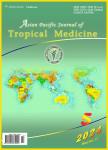High resolution melting real-time PCR detect and identify filarial parasites in domestic cats
High resolution melting real-time PCR detect and identify filarial parasites in domestic cats作者机构:Master of Science (Public Health) Program in Infectious Diseases and Epidemiology Faculty of Graduate Studies Mahidol University Department of Parasitology and Entomology Faculty of Public Health Mahidol University Center for Disease Control Vector Borne Disease Control Center 11.3 Surat Thani Province Department of Parasitology Faculty of Medicine Siriraj Hospital Mahidol University National Center for Genetic Engineering and Biotechnology (BIOTEC) National Science and Technology Development Agency (NSTDA)
出 版 物:《Asian Pacific Journal of Tropical Medicine》 (亚太热带医药杂志(英文版))
年 卷 期:2018年第11卷第12期
页 面:682-687页
核心收录:
学科分类:1002[医学-临床医学] 1001[医学-基础医学(可授医学、理学学位)] 100103[医学-病原生物学] 10[医学]
主 题:High resolution melting analysis Dried blood spot Brugia malayi Brugia pahangi Dirofilaria immitis
摘 要:Objective: To detect and identify filarial parasites in dried blood spots(DBS) collected from domestic cats using high resolution melting real-time PCR(HRM RT-PCR). Methods: A total of 208 DBS were collected from domestic cats in a brugian filariasis endemic areas in Surat Thani Province, southern Thailand. Microfilariae were found in 9 blood slides using Giemsa-stained thick blood film. The extracted DNA from blood spot volumes of 10 and 20 μL DBS with positive filarial parasites in cats were performed using HRM RT-PCR method. The primers were designed based on the partial mitochondrial 12S rRNA gene for identifying Brugia malayi, Brugia pahangi, Dirofilaria immitis. All purified samples were then detected. Results: Using different volumes of 10 μL and 20 μL DBS could easily distinguish filarial parasites and showed similar results. PCR amplicons of Brugia malayi, Brugia pahangi and Dirofilaria immitis were determined at melting peak(temperature) of 75.70℃, 77.46 ℃, and 73.56 ℃, respectively. All 9 positive DBS samples showed positive Brugia pahangi and similar nucleotide sequences. Conclusions: This HRM RT-PCR method is able to diagnose, identify and discriminate filarial parasites collected from DBS, which is simple and inexpensive compared with other probe-based genotyping methods. Furthermore, this method is useful to survey, prevent and control filariasis.



